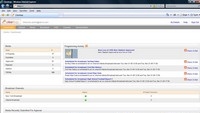IP paves the way for Clearleap file distribution

As the technology surrounding the Internet Protocol (IP) continues to mature and network bandwidth becomes more readily available, a new generation of applications is being developed to take advantage of the benefits of moving traditional video programs as packet-based data.
What once was considered a nascent distribution alternative for video destined for the Web and to be used as a non-real-time way to send video (and audio), IP infrastructures are now popping up across the country and allowing content owners and cable operators to quickly launch robust new services at a fraction of the cost of deploying new baseband video delivery systems. These new infrastructures also make it easy to add local content and Web-based programming to existing channel lineups, which heretofore have been mostly neglected.
Among these new technology choices is a new startup called Clearleap, based in Atlanta, GA, that has developed a software-based video delivery platform (targeting linear and VOD channels as well as digitally inserted commercials), leveraging the cost benefits of the Internet. It means that multichannel operators can bring new channels to subscribers faster and ads can be refreshed more frequently than is currently practical. It also makes hyperlocal content more financially attractive to cable operators looking to serve niche audiences.
The Clearleap platform was founded by a team of industry veterans and debuted at the 2009 Cable Show, in Washington, D.C. The IP-based back-end technology consists of a series of software modules that address specific segments of the content management and distribution process. The first to be introduced is called clear|flow, which simplifies the process of acquiring, managing and airing programs from any digital source. Content can range from national TV shows to locally originated shows and user-generated Web video, which can all be customized for local communities.
“Most of the content today is handheld via some type of tape-based system that has been a very labor-intensive process or it’s delivered via satellite, which is costly,” said Braxton Jarratt, company CEO and co-founder (with John Vecchio) and a former Cox Cable and N2 Broadband employee. “That has worked fine for a VOD model where subscribers pay for a popular movie they watch. However, if you have a vast array of content, some that might only be attractive to a select few, the old model doesn't work financially. This has limited subscribers’ choices and prevented the availability of hyperlocal content.”
He said it doesn’t make economic sense to distribute local content over a satellite infrastructure. With the Clearleap model, cable system operators allow access to content suppliers, who log into a Web interface and upload their programs. Clearleap’s data centers in Atlanta, Los Angeles and New York handle all of the transcoding, metadata formatting, file conversion and streaming services necessary to make it available to the cable operator as a MPEG-4 or QuickTime file (at about 1 Mb/s) — generating both a Flash version for browsing and QC as well as a high-resolution version for TV display. Clearleap can also reach into an operator’s existing library and make it available to the IPTV systems.
Once it’s available, using a typical VOD model, the operator then picks from a list of clips and sends it to their headend facility, where it is ordered and sent on to the home. And because the architecture is scalable in design, different operators will use it in different ways. Some companies might choose to have Clearleap manage the entire process.
The professional video industry's #1 source for news, trends and product and tech information. Sign up below.
The content is immediately processed and is made available on-demand within minutes or scheduled within a linear channel for later broadcast. Several small cable operators across the country are now using the Clearleap IPTV model in this way, according to Jarratt, to economically program local weather and sports channels.
“On a daily or weekly basis, an operator can provide access to a local high school or news organization, so that they can manage it all through the Web,” Jarratt said. “What we’re doing is bringing all of the immediacy and flexibility of the Internet to the television environment, in an efficient and cost-effective way.”
Local advertising can also take advantage of this Internet-centric model, as new spots can be quickly added and replaced to program schedules (as soon as five minutes before it goes to subscribers) with a few mouse clicks. The company’s clear|profit module enables this, reducing the time to market for ad campaigns from months to hours, while increasing the opportunities for targeted advertising.
Clearleap has invested significantly in its networking infrastructure, which was required to enable cable operators to accept content 24 hours a day. This helps customers save on transmission costs and other resources — such as manpower and server space — that would otherwise be needed to maintain a new IP channel in this way. Clearleap charges its customers based on volume usage, that is, how many videos are being uploaded and served by the system.
While IP has been most successful in “green field” installations being built from scratch, Clearleap is also targeting existing cable operators with established infrastructures. To this end, Jarratt said the software can make MPEG-4 files available to the large installed base of MPEG-2 set-top boxes.
Clearleaps’ hybrid IP approach to supporting broadcast and interactive services, where linear channels give way to on-demand usage, appears to be catching on throughout the industry — in a myriad of forms and from an increasing number of vendors. The key is taking the variety of existing network infrastructures that have proven to be beneficial for file delivery and marrying them with a traditional video delivery platform.
“Most of our current customers are taking the time and money that our platform frees up and investing it in more content,” Jarratt said. “That’s helping operators expand their services significantly at minimal costs. IP is the future because it provides a very clear value proposition.”
